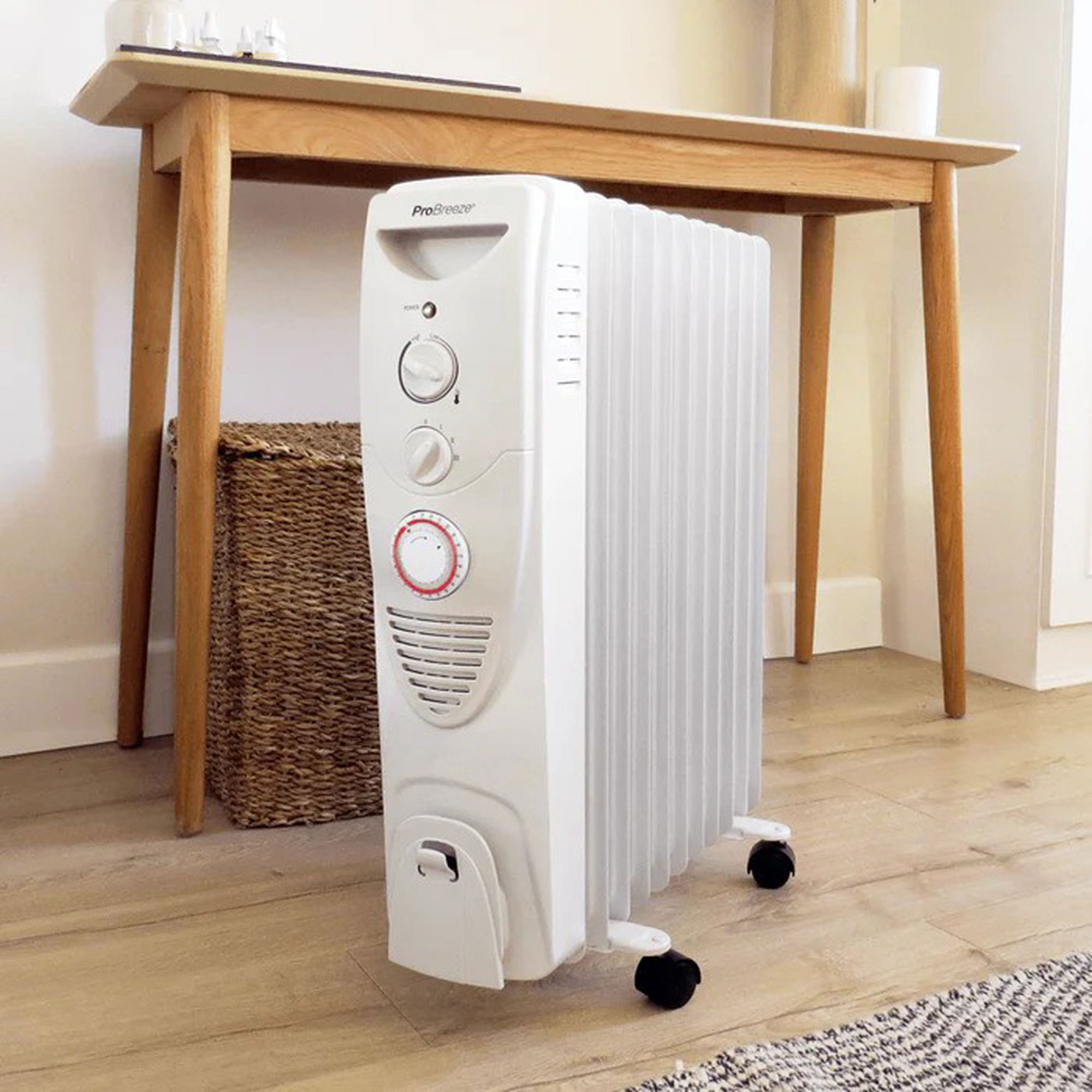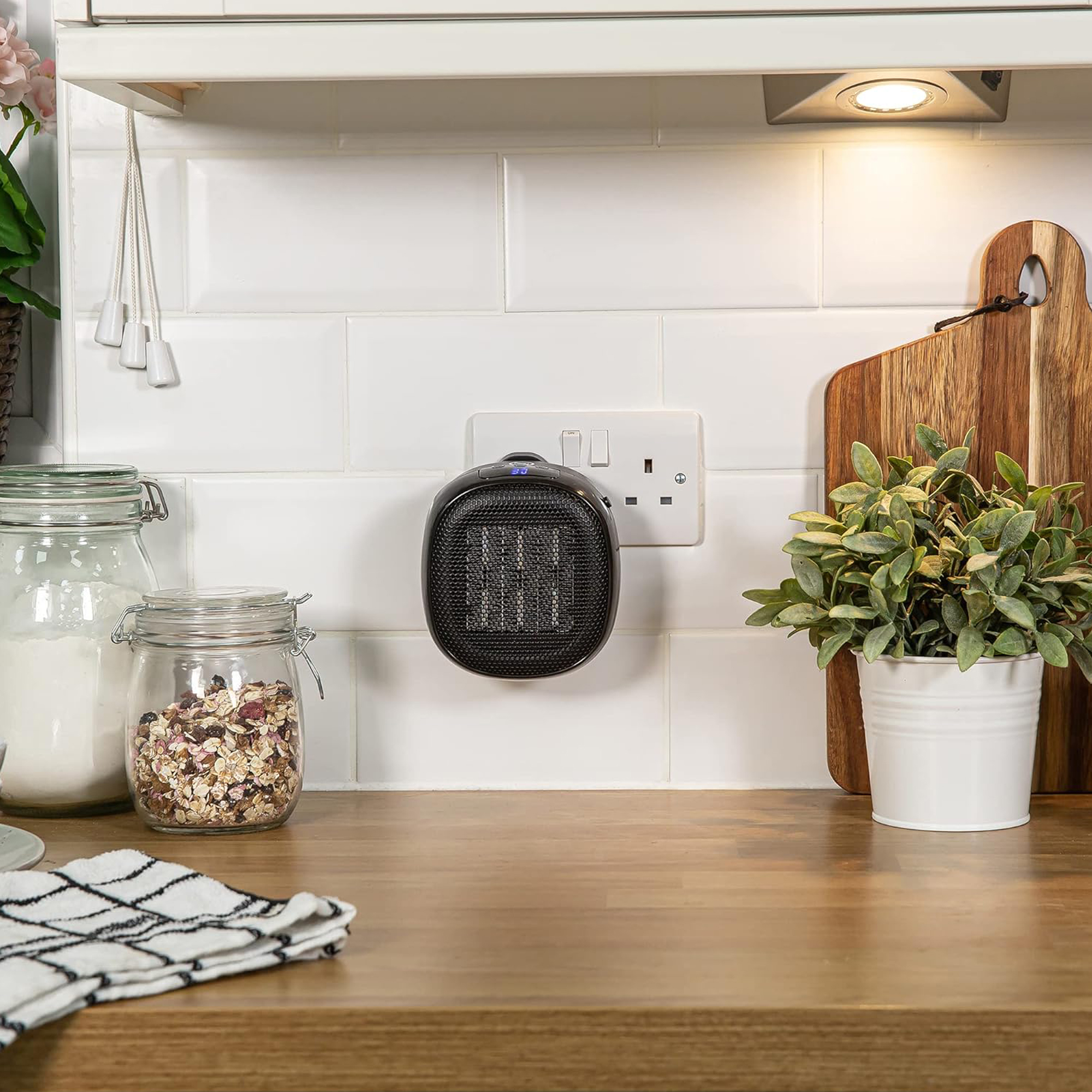Oil-filled radiator vs fan heater—which one is best for staying warm on a budget this winter?
We pipped these two portable heaters against each other


Katie Sims
Portable heaters are a great way to keep heating bills low when temperatures drop. The best oil-filled radiators and fan heaters are two of the most popular options, but if you're buying one new, should you opt for an oil-filled radiator or a fan heater?
Choosing the best electric heater on the market is even more important now in light of the latest energy price cap change, which came into effect on 1st January 2025. As Ofgem have rung in the New Year with a 1.2% increase in our energy bills for the next three months (which equates to a £21 increase in average energy bills across the UK), turning the central heating on has become even more of a luxury.
Fortunately, oil-filled radiators and fan heaters could be the saving grace you need to keep your home warm this winter. We've spoken to energy and heating experts and outlined everything you need to know about these two types of heaters, to help you choose which one is right for you.
Oil-filled radiator vs fan heater

The makers of our favourite dehumidifier, the Pro Breeze 1500ml Mini, have now taken over the oil-filled radiator world, too. In fact, this Pro Breeze offering has taken the crown as the 'best overall' in our list of the best oil-filled radiators.

This Beldray was crowned the 'best budget fan heater' in our guide, making it the perfect option for those who want to stay warm on a budget. Plus, our reviewer praised it for how easy it was to use.
Oil-filled radiator vs fan heater: What’s the difference?
Finding the right heater for your home, your family, and your specific needs can sometimes feel like a minefield. But nine times out of ten, you’ll probably whittle down your search to two options; an oil-filled radiator or a fan heater. But what’s the difference, and how do they both work?
Nicholas Auckland, heating expert at Trade Radiators, says, ‘When it's really cold, sometimes the radiator in the room just isn't enough to heat the whole space, so portable heaters are ideal.’ That’s exactly what these two heaters are, but they create heat in very different ways.
An oil-filled radiator is exactly what it says. It’s essentially a radiator filled with thermal oil that’s heated using an electrical element. As the oil heats up, it serves as a convention heater and emits heat through its columns - which are commonly called ‘fins.’
A fan heater is also very simple to understand. This appliance heats a room by passing air over a heat source, which is then pumped into the room.
Get the Ideal Home Newsletter
Sign up to our newsletter for style and decor inspiration, house makeovers, project advice and more.

Nicholas Auckland is a heating and energy expert with over 10 years of experience in the industry, as well as the Managing Director of Trade Radiators. Nicholas is dedicated to finding the best heating solutions for every need, as well as optimising energy usage, reducing costs and helping others live with lower-cost energy bills.
Oil-filled radiator vs fan heater: Which produces more heat?
When you’re searching for a heater for your home, how much heat it produces is something you need to consider if you want to get the most bang for your buck. After all, the longer you leave the heater on, the more energy it will be using.
In terms of heat production, oil-filled radiators and fan heaters are interchangeable. You’ll find that both appliances come with thermostats and temperature controls that allow you to choose the ideal temperature for the room you’re trying to heat up. This means that you can turn it up as high or turn it down as low as you want, depending on your needs and requirements.
However, there are some distinguishable differences between the two types of heaters, including the speed at which they heat up, how that heat is distributed, and heat retention.
Fan heaters are generally quicker to heat up a room than oil-filled radiators, but they can often struggle with heat distribution. This was something our expert tester, Rachel Ogden, found when she tested the Beldray Flatbed Portable Fan Heater.

She said, ‘For its size, the Beldray fan is a hard worker. Even on its lowest setting, it supplies a good boost of heat instantly. However, that heat has a limited reach and took a while to diffuse around the whole room when tested. Close up, the Beldray is cosy, but it would probably be a costly way to heat a medium-to-large room from cold.’
On the other hand, oil-filled radiators are generally a bit slower to heat up but have a better heat distribution. This could be seen when another one of our expert testers, Rachel Tompkins, tried out the Pro Breeze 2500W 11 Fins Oil Filled Radiator.
‘Sitting next to it in my office, I could feel the heat radiating on my legs within minutes and in less than ten minutes, my office (which measures approximately 2m x 3m) felt warm and cosy,’ she said. ‘This heating performance is streets ahead of others tested, and it had a real impact even on larger rooms, such as a bedroom measuring 4.5 x 3.5 metres.’

While these two heating appliances offer the chance to take the chill away from a cold house, it’s important to note that they’re also very different in terms of heat retention - and this is something you should definitely consider if you’re tightening up the purse strings.
As oil-filled radiators rely on the hot oil inside of the radiator itself, they’ll continue to heat a room until the oil cools down again, which allows you to make the most of extra heat even after you’ve turned it off. This isn’t the case for a fan heater, though.
Nicholas says, ‘Electrical fan heaters have significant heating power, but once they’re off, the space will cool down rapidly as there will no longer be hot air being blown through it.’
This means that if you’re looking to squeeze out a little extra heat for free, an oil-filled radiator will suit you better.
Oil-filled radiator vs fan heater: Which is bigger?
If wondering whether you should be heating your whole house or just the room you’re using and you opt for the latter, a portable heater such as an oil-filled radiator or fan heater is the way to go. As long as you have a plug socket nearby, you can plug either of these heaters into the mains and heat up any room you like.
However, you might want to consider the size of these appliances before you whip out your credit card, as these two heaters are very different.
Fan heaters are generally much smaller than oil-filled radiators, and many of the best fan heaters on the market are a similar size to the best dehumidifiers. This means that they can easily be hidden in cupboards or behind the sofa when you’re not using them. Not only that, but the Russell Hobbs Compact Portable Ceramic Plug-in Fan Heater, available on Amazon is only slightly bigger than your average phone charger.

Oil-filled radiators, on the other hand, are generally much bigger, but this does depend on the number of fins you choose. An oil-filled radiator with 11 fins is usually twice the size of an oil-filled radiator with 6 fins - but this will ultimately affect its heating qualities.
Of course, these fins also make the radiators extremely bulky, making them harder to hide or squeeze into small spaces. Because of this, a fan heater might be more up your street if you have a smaller home.
Oil-filled radiator vs fan heater: Which is more affordable?
If you’re on the lookout for the cheapest electric heater to run, you need to consider two things: the general price of the product and how much it will cost you to run that particular product.
When it comes to the general price of the product, it’s hard to compare oil-filled radiators and fan heaters as they’re fairly similar. The Vonhaus 800W 6 fin Oil Filled Radiator, available on Amazon is the cheapest oil-filled radiator the Ideal Home team has tested, and it has an RRP of £29.99. At the other end of the spectrum, we’ve also tested the De’Longhi 2500W Dragon 4 Oil-Filled radiator, from Argos, which has an RRP of £186.99.
Similarly, you can find good quality fan heaters with very different price points, too. The Beldray Flatbed Portable Fan Heater will set you back just £19.99, but you could also opt for the Duux Threesixty 2 Ceramic Electric Heater, from John Lewis, which retails at £99.99. It’s ultimately a good idea to set your own personal budget to find the best price for you.
But what about running costs? Well, the cost to run an oil-filled radiator can vary depending on the wattage of the device.
On oil-filled radiators, Nicholas says, ‘Cost of running units can vary in size from 500 - 2500 Kw, but at current rates, you’re looking at running costs of approximately 12p - 62p an hour.’
Fan heaters typically use 2kW of power to run, which means they’ll cost around 50p per hour to run on full power. 'So if you used a 2000W fan heater for four hours a day, 7 days a week, it would cost you around £14,' Nicholas explains. 'Whereas an 2500W oil-filled radiator would cost £17.43 to run for the same amount of time.'
When budgeting for either type of heater, factor in the wattage of the device. The higher the wattage, the more it will cost to run, and this is true of both fan heaters and oil-filled radiators.

Final verdict: Which one do you need?
The debate between oil-filled radiators and fan heaters is a difficult one. In terms of buying the appliance and the running costs, these two portable heaters are on a fairly even keel.
In terms of aesthetics and heat distribution, however, these two heaters are very different - and this is where personal preference comes into the picture.
If you live in a smaller house, want a heater that looks a little more sleek and stylish, and want instant heat, a fan heater will tick all of your boxes. However, they're not the most efficient way to heat a house, and you would does have to deal with a lack of heat retention.
But if you have more space in your home and you want to squeeze as much heat out of your portable heater as possible, an oil-filled radiator would definitely suit you better. The impressive heat retention of an oil-filled radiator means that you can get a lot more bang for your buck - but it’s definitely less attractive than a fan heater alternative.
FAQs
Are oil-filled radiators cheaper to run than fan heaters?
In terms of running costs, oil-filled radiators and fan heaters are fairly similar, because of the range of models available. You should expect to pay anywhere between 12p - 62p an hour to run an oil-filled radiator, and a 2kWh fan heater costs around 50p to run.
However, it’s also important to note that oil-filled radiators take longer to heat up, which means that you may have to keep it on for longer than a fan heater. But when you consider the fact that oil-filled radiators retain their heat for much longer than fan heaters, this means that you’ll probably run them for the same amount of time in the end.
'Oil-filled radiators are better suited for longer, more consistent heating,' Les Roberts, energy expert at Bionic confirms. 'The oil inside retains heat, allowing the radiator to cycle off more frequently while still radiating warmth. This makes them more energy-efficient for extended use.'
Do oil-filled radiators use a lot of power?
Oil-filled radiators vary in terms of power usage, with models ranging from 500 -2500 Kw. They use a lot of power just to get warm in the first place, which is arguably their main drawback.
'The oil inside needs time to warm and it can take a while before the radiator starts to release heat effectively,' Les says. 'While this makes them less suitable for quick warmth, they becomes more efficient for maintaining consistent heat over an extended period once it reaches temperature.'
Oil-filled radiators retain their heat extremely well, which is what makes them economical.
Now you’ve got the lowdown on the oil-filled radiator vs fan heater debate, you should have all of the information you need to stay warm this winter.

Lauren Bradbury has been the Content Editor for the House Manual section since January 2025 but worked with the team as a freelancer for a year and a half before that. She graduated with a Bachelor’s degree in English and Creative Writing from the University of Chichester in 2016. Then, she dipped her toe into the world of content writing, primarily focusing on home content. After years of agency work, she decided to take the plunge and become a full-time freelancer for online publications, including Real Homes and Ideal Home, before taking on this permanent role. Now, she spends her days searching for the best decluttering and cleaning hacks and creating handy how-to guides for homeowners and renters alike, as well as testing vacuums as part of her role as the Ideal Home Certified Expert in Training on Vacuums, having spent over 110 hours testing different vacuum models to date!
- Katie SimsContributor
-
 5 fragrant shrubs that will fill your garden with a gorgeous scent this summer
5 fragrant shrubs that will fill your garden with a gorgeous scent this summerAdd an extra dimension to your outdoor space with these scented shrubs
By Kezia Reynolds
-
 Should your front door colour match your hallway? Interior experts reveal 3 reasons why it should (and 3 reasons it shouldn't)
Should your front door colour match your hallway? Interior experts reveal 3 reasons why it should (and 3 reasons it shouldn't)Are you team matching or contrasting?
By Ellis Cochrane
-
 This £200 limited-time discount makes this Dyson vacuum cheaper than I’ve ever seen it - run don’t walk to Argos for this bargain
This £200 limited-time discount makes this Dyson vacuum cheaper than I’ve ever seen it - run don’t walk to Argos for this bargainIt's the most affordable Dyson on the market right now
By Lauren Bradbury
-
 Aldi is releasing a budget alternative to the cult Joseph Joseph washing up bowl – it’s just £4.99
Aldi is releasing a budget alternative to the cult Joseph Joseph washing up bowl – it’s just £4.99The Joseph Joseph washing up bowl is an Ideal Home favourite - now we can't wait to try Aldi's alternative
By Kezia Reynolds
-
 I just bought my first home, and this £10 buy was the very first thing I bought for it to make it feel warmer and secure
I just bought my first home, and this £10 buy was the very first thing I bought for it to make it feel warmer and secureIf I did it all again, this would still be my very first buy
By Rebecca Knight
-
 It’s normally impossible to find a Dyson vacuum for under £250 — but QVC has slashed the price of their bestselling models for a limited time
It’s normally impossible to find a Dyson vacuum for under £250 — but QVC has slashed the price of their bestselling models for a limited timeRun don’t walk to pick up the brand’s bestselling model for under £230 before it sells out
By Lauren Bradbury
-
 Catherine Zeta-Jones has revealed the cleaning product she swears by to keep her home fresh - and it’s just £8 on Amazon
Catherine Zeta-Jones has revealed the cleaning product she swears by to keep her home fresh - and it’s just £8 on Amazon'I use it on my counters. I use it on my walls. I use it on my doors. When I smell it, I know my house is clean.'
By Kezia Reynolds
-
 I tested the 12L Challenge dehumidifier in my damp Victorian home over winter — I haven’t spotted any signs of mould for the first time in five years
I tested the 12L Challenge dehumidifier in my damp Victorian home over winter — I haven’t spotted any signs of mould for the first time in five yearsThe Challenge 12L dehumidifier doesn’t have too many bells and whistles, but I can already see the difference it’s made to my damp home
By Lauren Bradbury
-
 What is boiler flow temperature? Heating experts urge you to check yours now as you could be overpaying on your energy bills
What is boiler flow temperature? Heating experts urge you to check yours now as you could be overpaying on your energy billsTurning this little-known number down just a few degrees can result in some serious savings
By Lauren Bradbury
-
 Stacey Solomon has shared 5 nifty wardrobe storage hacks to make getting ready in the morning easier — and they're genius
Stacey Solomon has shared 5 nifty wardrobe storage hacks to make getting ready in the morning easier — and they're geniusThese five wardrobe storage hacks are a gamechanger
By Katie Sims
-
 Cult cleaning brand Scrub Daddy has just launched a brand new butterfly mop — could it be the ultimate solution for banishing stubborn marks on your floor?
Cult cleaning brand Scrub Daddy has just launched a brand new butterfly mop — could it be the ultimate solution for banishing stubborn marks on your floor?We're obsessed with all things Scrub Daddy
By Kezia Reynolds